标签:and 薪资 nta sele 代言 asc 男女比例 like 使用
create table emp( id int not null unique auto_increment, name varchar(32) not null, gender enum(‘male‘,‘female‘,‘other‘) not null default ‘male‘, age int(3) unsigned not null default 28, hire_date date not null, post varchar(64), post_comment varchar(100), salary double(15,2), office int, depart_id int ); ? # 插入记录 三个部门:教学部 销售部 运营部 insert into emp(name,gender,age,hire_date,post,salary,office,depart_id) values (‘jason‘,‘male‘,18,‘20170301‘,‘张江第一帅形象代言‘,7300.33,401,1), ? (‘egon‘,‘male‘,78,‘20150302‘,‘teacher‘,1000000.31,401,1), # 以下是教学部 (‘kevin‘,‘male‘,81,‘20130305‘,‘teacher‘,8300,401,1), (‘tank‘,‘male‘,73,‘20140701‘,‘teacher‘,3500,401,1), (‘owen‘,‘male‘,28,‘20121101‘,‘teacher‘,2100,401,1), (‘jerry‘,‘female‘,18,‘20110211‘,‘teacher‘,9000,401,1), (‘nick‘,‘male‘,18,‘19000301‘,‘teacher‘,30000,401,1), (‘sean‘,‘male‘,48,‘20101111‘,‘teacher‘,10000,401,1), ? (‘歪歪‘,‘female‘,48,‘20150311‘,‘sale‘,3000.13,402,2),#以下是销售部门 (‘丫丫‘,‘female‘,38,‘20101101‘,‘sale‘,2000.35,402,2), (‘丁丁‘,‘female‘,18,‘20110312‘,‘sale‘,1000.37,402,2), (‘星星‘,‘female‘,18,‘20160513‘,‘sale‘,3000.29,402,2), (‘格格‘,‘female‘,28,‘20170127‘,‘sale‘,4000.33,402,2), ? (‘张野‘,‘male‘,28,‘20160311‘,‘operation‘,10000.13,403,3), #以下是运营部门 (‘程咬金‘,‘male‘,18,‘19970312‘,‘operation‘,20000,403,3), (‘程咬银‘,‘female‘,18,‘20130311‘,‘operation‘,19000,403,3), (‘程咬铜‘,‘male‘,18,‘20150411‘,‘operation‘,18000,403,3), (‘程咬铁‘,‘female‘,18,‘20140512‘,‘operation‘,17000,403,3) ;
# 初识查询语句 select id,name from emp where id >= 3 and id <= 6; # 翻译:展示emp表中id大于等于3且小于等于6这些数据的id和name ‘‘‘ 执行顺序: from # 确定是那张表 where # 根据条件,筛选数据 group by # 分组
having # 对分组后的表筛选 select # 拿出筛选出来的数据中的某些字段
distinct # 去重
‘‘‘ # 关键字 where group by 同时出现的情况下,group by 必须在 where 之后 # where 先对整张表进行一次筛选,group by 再对筛选后的表进行分组 # 如何验证where是在group by之前执行而不是之后 利用聚合函数 因为聚合函数只能在分组之后才能使用 select id,name,age from emp where max(salary) > 3000; # 报错! ? select max(salary) from emp; # 正常运行,不分组意味着每一个人都是一组,等运行到max(salary)的时候已经经过where,group by操作了,只不过我们都没有写这些条件

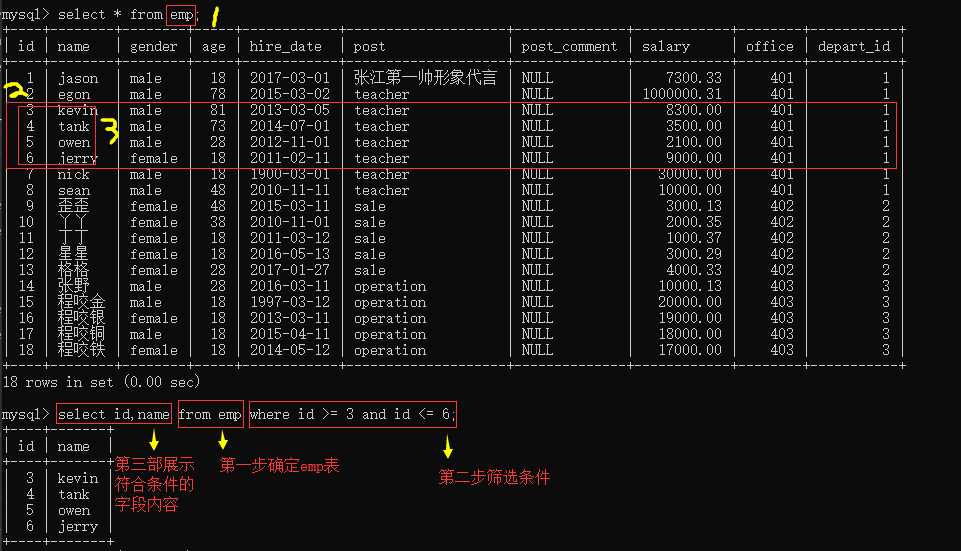
# 1.查询id大于等于3小于等于6的数据 解析: 筛选条件:id大于等于3小于等于6 展示字段:没要求展示全部 select * from emp where id >= 3 and id <= 6; select * from emp where id between 3 and 6; # 另一种写法


# 2.查询薪资是20000或者18000或者17000的数据 解析: 筛选条件:薪资是20000或者18000或者17000 展示字段:没要求展示全部 select * from emp where salary = 20000 or salary = 18000 or salary = 17000; select * from emp where salary in (20000,18000,17000); # 另一种写法


# 3.查询员工姓名中包含o字母的员工姓名和薪资 解析: 筛选条件:员工姓名中包含o字母, 展示字段:姓名和薪资 ps:模糊匹配 like % 匹配多个任意字符 _ 匹配一个任意字符 select name,salary from emp where name like ‘%o%‘;


# 4.查询员工姓名是由四个字符组成的员工姓名与其薪资 解析: 筛选条件:员工姓名是由四个字符组成 展示字段:姓名与薪资 select name,salary from emp where name like ‘____‘; select name,salary from emp where char_length(name) = 4; # 统计字符长度


# 5.查询id小于3或大于6的数据 解析: 筛选条件:id小于3或大于6 展示字段:全部 select * from emp where id <3 or id > 6; select * from emp where id not between 3 and 6;

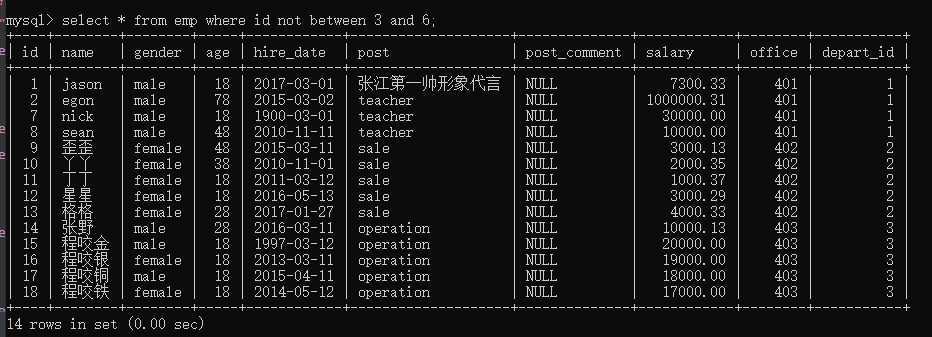
# 6.查询薪资不在20000,18000,17000范围的数据 解析: 筛选条件:薪资不在20000,18000,17000范围 展示字段:全部 select * from emp where salary not in (20000,18000,17000);
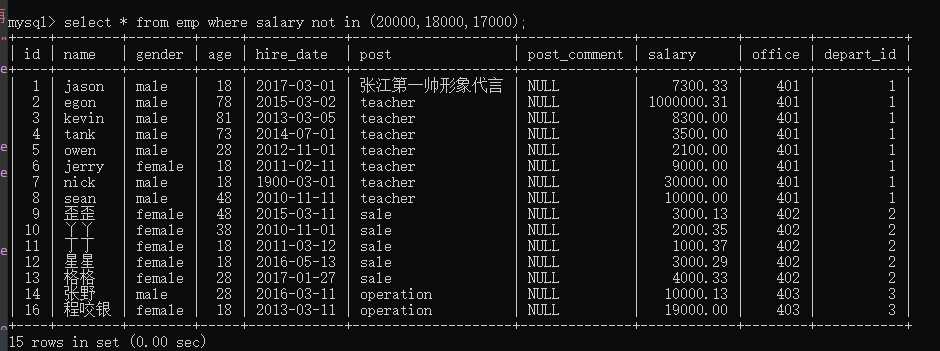

# 7.查询岗位描述为空的员工名与岗位名 解析: 筛选条件:岗位描述为空 展示字段:员工名与岗位名 select name,post from emp where post_comment = null; # 查询为空 select name,post from emp where post_comment is null; # 判断空只能用 is # 查询岗位描述为不空的员工名与岗位名 select name,salary from emp where post_comment is not null;

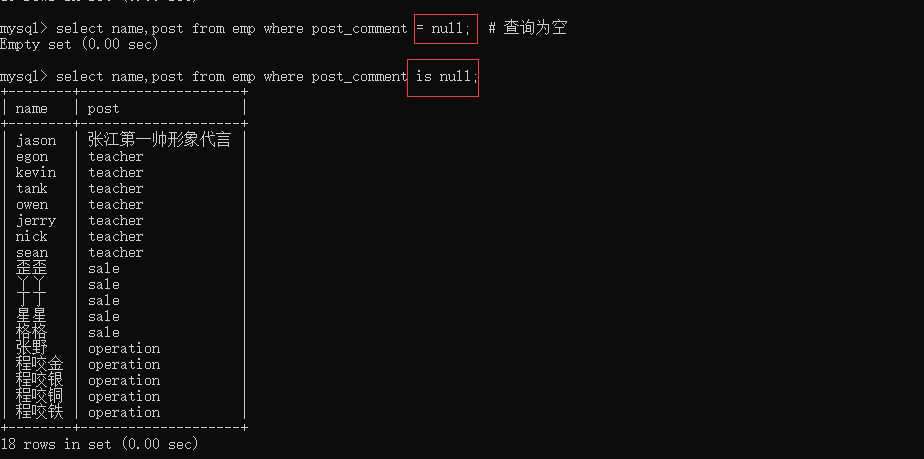
# 数据分组应用场景: 每个部门的平均薪资,男女比例等 初识语句: select * from emp group by post; # 分组后拿到的是每组的第一条数据 select id,name,gender from emp group by post; #报错 分组后应该做到最小单位是组,而不应该在展示组内的单个数据信息 分组之后,只能拿到分组的字段信息,无法直接获取其他字段信息,但是可以通过(聚合函数)间接获取 ‘‘‘ 设置sql_mode为only_full_group_by,意味着以后分组,只能取到分组的依据,不应该再取组里面的单个元素值,那样分组就没有意义了,因为不分组就是对单个元素信息的随意获取 ‘‘‘ show variables like ‘%mode%‘; set global sql_mode="strict_trans_tables,only_full_group_by"; 设置严格模式后要重启mysql # 注意: 如果一张表没有group by 默认所有的数据就是一个组


# 设置严格模式后 select * from emp group by post; # 报错 select id,name from emp group by post; # 报错 # 1.按部门分组 select post from emp group by post; # 强调 分组后就不能直接查到单个数据信息了,只能获取组名
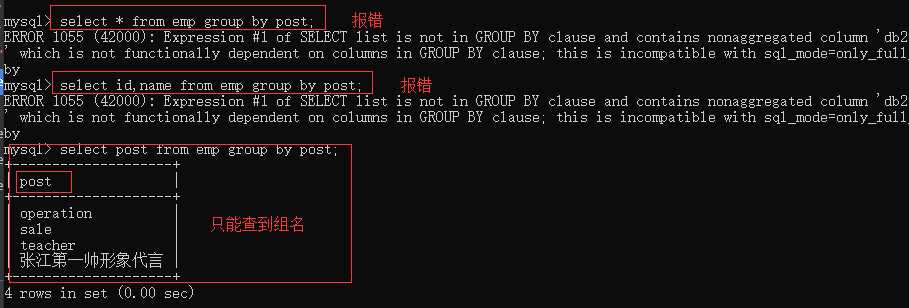

# 以组为单位,统计组内数据>>>聚合查询(数据聚集到一起计算结果) # 必须在分组之后使用 # 聚合函数会自动将每一个分组内的单个数据做想要的计算 max() 最大值 min() 最小值 avg() 平均值 sum() 求和 count() 计数,有几个计算几个 concat() 一般用来拼接字符串 # 不在组内使用 group_concat() 用来显式组内指定字段对应的数据或拼接字符串的作用
# 2.获取每个部门的最高工资 解析: 筛选条件:无 分组:按部门 展示:部门的最高工资 select post,max(salary) from emp group by post;


# 每个部门最低工资 select post,min(salary) from emp group by port; # 每个部门平均工资 select post,avg(salary) from emp group by post; # 每个部门工资总和 select post,sum(salary) from emp group by post; # 每个部门的人数 select post,count(id) from emp group by post; # 按id计数 select post,count(age) from emp group by post; # 按年龄计数 select post,count(salary) from emp group by post; # 按薪资计数 select post,count(post_comment) from emp group by post; # 注意: 在统计分组内个数的时候,填写任意非空字段都可以完成统计,推荐使用id字段
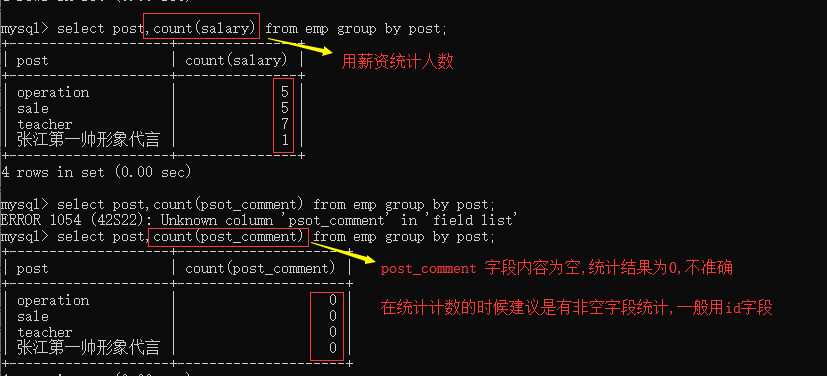

# 3.查询分组之后的部门名称和每个部门下所有的学生姓名 解析: 筛选条件:无 分组:按部门 展示:部门名称 每个部门下所有的学生姓名 select post,name from emp group by post; # 报错 select post,group_concat(name) from emp group by post; select post,group_concat(‘NB_‘,name) from emp group by post; # 拼接字符串 select post,group_concat(name,‘:‘,salary) from emp group by post;

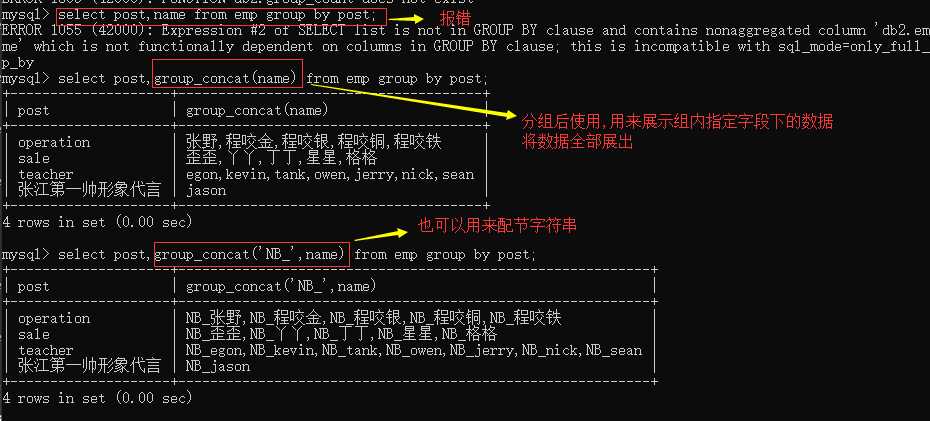
# 4.补充concat(不分组时用)拼接字符串达到更好的显示效果 as语法使用 select concat("NAME: ",name) as 姓名,concat("SAL: ",salary) as ‘薪资‘ from emp;

# 补充as语法 即可以给字段起别名也可以给表起 select emp.id,emp.name from emp as t1; # 报错 因为表名已经被你改成了t1 select t1.id,t1.name from emp as t1; # 查询四则运算 # 查询每个人的年薪 select name,salary*12 as ‘年薪‘ from emp;


1. 查询岗位名以及岗位包含的所有员工名字 解析: 筛选条件:无 分组:按岗位 展示:岗位名,岗位里的所有员工名字 select post,group_concat(name) from emp group by post; 2. 查询岗位名以及各岗位内包含的员工个数 解析: 筛选条件:无 分组:按岗位 展示:岗位名,岗位里的员工个数 select post,count(id)from emp group by post; 3. 查询公司内男员工和女员工的个数 解析: 筛选条件:无 分组:按性别 展示:性别,男女个数 select gender,count(id) from emp group by gender; 4. 查询岗位名以及各岗位的平均薪资 解析: 筛选条件:无 分组:按岗位 展示:岗位,平均薪资 select post,avg(salary) from emp group by post; 5. 查询岗位名以及各岗位的最高薪资 解析: 筛选条件:无 分组:按岗位 展示:岗位,最高薪资 select post,max(salary) from emp group by post; 6. 查询岗位名以及各岗位的最低薪资 select post,min(salary) from emp group by post; 7. 查询男员工与男员工的平均薪资,女员工与女员工的平均薪资 解析: 筛选条件:无 分组:按性别 展示:;性别,平均薪资 select gender,avg(salary) from emp group by gender; 8.统计各部门年龄在30岁以上的员工平均工资 解析: 筛选条件:年龄在30岁以上 分组:按部门 展示:;部门,平均薪资 select post,avg(salary) from emp where age > 30 group by post;
having 的语法格式与 where 一致,只是 having 是在分组之后进行过滤筛选 where 不能用聚合函数,但是 having 可以用聚合函数 1、统计各部门年龄在30岁以上的员工平均工资,并且保留平均工资大于10000的部门 解析: where筛选:年龄在30岁以上 group by分组:部门 having筛选:保留平均工资大于10000部门 select展示:部门,平均薪资 select post,avg(salary) as ‘平均薪资‘ from emp where age > 30 group by post having avg(salary) > 10000; select * from emp where salary > 10000; # 对 select avg(salary) from emp having salary > 10000; # 错 select avg(salary) from emp having avg(salary) > 10000; # 对 select post,avg(salary) from emp group by post having avg(salary) > 10000 ; # 对 select max(salary) from emp where age > 20; # 对 select max(salary) from emp having age > 20; # 错


# 对有重复的展示数据进行去重 select distinct post from emp; select distinct age from emp; select distinct id,age from emp; # 不能去重,id + age 组合的数据没有重复的 ‘‘‘ 去重的数据必须是一模一样的,只要有一个不一样都不能去重 distinct 在select之后执行 ‘‘‘


1.asc 升序 2.desc 降序 # 1.按salary排序 select * from emp order by salary asc; # 默认升序 select * from emp order by salary desc; # 降序 # 2.按age降序排,年龄相同的情况下按salary升序拍 select * from emp order by age desc,salary asc;




# 3.统计各部门年龄在10岁以上的员工平均工资,并且保留平均工资大于1000的部门,然后对平均工资进行排序 解析: where筛选:年龄在10岁以上 group by分组:按部门 having筛选:并且保留平均工资大于1000的部门 order by排序:平均工资 select展示:部门,平均工资 select post,avg(salary) from emp where age > 10 group by post having avg(salary) > 1000 order by avg(salary) asc;


# 限制展示3条数据 select * from emp limit 3; # 查询工资最高的人的详细信息 解析: 按工资降序,再显示一条数据,就是工资最高的人的详情信息 select * from emp order by salary desc limit 1; # 分页显示 select * from emp limit 0,5; # 第一个参数是起始位置,第二个参数是显示的条数

select * from emp where name regexp ‘^j.*(n|y)$‘;
标签:and 薪资 nta sele 代言 asc 男女比例 like 使用
原文地址:https://www.cnblogs.com/waller/p/11391759.html